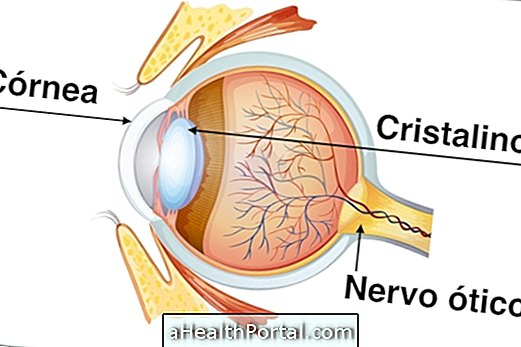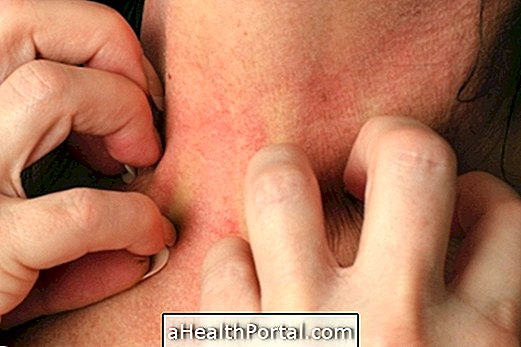The white spot on the eye, also called leukocoria, appears more often in the pupil and may be indicative of serious diseases such as retinoblastoma or congenital cataract.
The causes of white spot in the eye can be identified right at birth through the test of the little eye, which is a test performed at the maternity hospital provided by SUS. Understand how the little eye test is done.

Main causes of white spot on the eye
White spots may be indicative of diseases in the fundus of the eye, lens or cornea and the main causes of the appearance of spots are:
1. Retinoblastoma
Retinoblastoma is a rare type of cancer that can happen in one or both eyes and occurs more often in children. This disease can be easily identified through the test of the little boy still in the maternity or the first consultation with the pediatrician, and has as main symptoms difficulty in seeing, redness in the eye and strabismus, besides the presence of the white spot in the eye.
When identified early, retinoblastoma can be treated and leaves no sequelae. The treatment varies according to the degree of the disease, and can be performed with laser or cold application in place to destroy the tumor, or undergo chemotherapy in the most severe cases. Learn how to identify and treat retinoblastoma.
2. Cataract
Cataracts are a disease characterized by progressive loss of vision, being more common in people over 60 because of the lens's aging lens. However, it can also happen soon after birth, being called a congenital cataract, which is characterized by malformation of the lens during the development of the fetus, which can reach one or both eyes. Understand more about cataracts and congenital cataracts.
The characteristic sign of cataracts is the presence of a white spot on the pupil that can impair vision, leaving it blurred, or even leading to complete loss of vision. Treatment should be done as soon as possible so that there is no more serious progression, such as total loss of vision, and is usually done through surgery to replace the lens. See how cataract surgery is done.

3. Toxocariasis
Toxocariasis is an infectious disease caused by the presence of the parasite Toxocara sp. This parasite, when it reaches the eye, can cause redness, pain or itching in the eye, decreased vision and white patches on the pupil.
Ocular toxocariasis is more common in children who play on the ground, sand or on the ground, as it is usually the habitat of Toxocara. Learn more about toxocariasis.
4. Hyperplastic Persistence of the Primitive Vitreous
The hyperplastic persistence of the primitive vitreous, also called fetal vascularization, is a rare malformation of the baby's eyes that leads to the formation of a white membrane within the eye. This disease has no genetic character and is more common in preterm infants.
Depending on the extent of the disease, there may be some complications, such as difficulty seeing, glaucoma, and strabismus, for example. Here's how to identify fetal vascularization and how the treatment is done.
When to go to the doctor
It is important to go to the ophthalmologist when the following changes are noticed:
- Difficulty in seeing;
- Blurred vision;
- Night blindness;
- Presence of eye spots;
- Pain or itching in the eye.
Through the analysis and evaluation of symptoms and other complementary tests, the ophthalmologist can make the diagnosis and establish the most appropriate treatment for each situation.



















